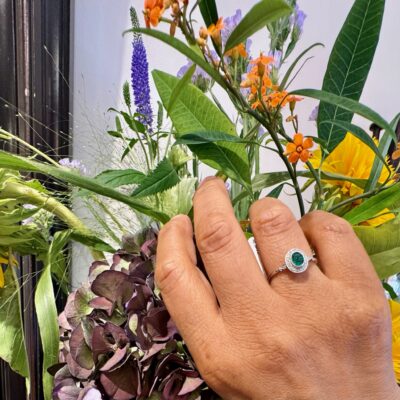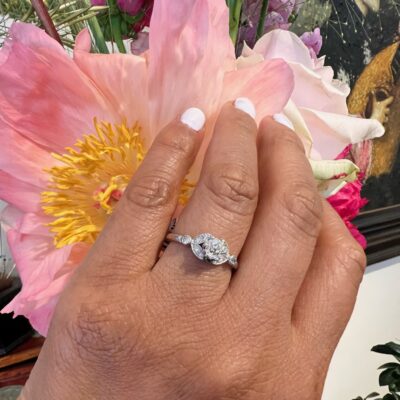Peruzzi-cut diamond: The Historic Gem of Baroque Brilliance
The Peruzzi-cut diamond is an antique diamond cut that dates back to the late 17th century, known for its historical significance and its role in the evolution of diamond cutting techniques. Named after Venetian gem-cutter Vincenzo Peruzzi, who is credited with refining the diamond cutting process, the Peruzzi cut was an important predecessor to modern brilliant cuts and was favored during the Baroque period for its enhanced brilliance and symmetry.
The Peruzzi cut typically features 56 facets, more than the earlier "Mazarin" cut, which had only 34 facets, but fewer than the 58 facets found in the modern round brilliant cut. This increase in facets allowed the Peruzzi-cut diamond to reflect more light, resulting in greater brilliance and sparkle. The cut is usually square or slightly rectangular in shape, with a high crown and a small table, characteristics that give it a distinctive, antique charm.
Historically, the Peruzzi cut was highly valued in European courts and among the aristocracy for its superior light performance compared to earlier diamond cuts. It played a significant role in the transition from the old, simpler cuts to the more complex and brilliant cuts that would eventually dominate the diamond market. The Peruzzi cut was one of the first to consider the optical properties of diamonds, paving the way for the modern understanding of diamond brilliance.
In modern times, Peruzzi-cut diamonds are primarily found in antique and vintage jewelry, where they are cherished for their historical significance and unique beauty. Collectors and enthusiasts appreciate these diamonds for their connection to the Baroque era and their role in the development of diamond cutting techniques. The Peruzzi cut’s combination of old-world charm and early brilliance makes it a rare and valuable find.
A Peruzzi-cut diamond is more than just a gemstone; it is a piece of history, capturing the elegance and innovation of the Baroque period. Its unique facet arrangement and antique appeal make it a perfect choice for those who appreciate the craftsmanship and beauty of historical jewelry. Whether set in a period piece or used to create a vintage-inspired design, a Peruzzi-cut diamond offers a glimpse into the rich history of diamond cutting and the timeless allure of classic elegance.
Single-cut diamond: The Classic Sparkle of Timeless Elegance
Single-cut diamonds are a classic and elegant choice in the world of fine jewelry, known for their understated yet captivating sparkle. Unlike modern brilliant-cut diamonds, which typically have 58 facets, single-cut diamonds have fewer facets—usually 17 or 18—resulting in a simpler, more traditional appearance.
Historically, single-cut diamonds were among the earliest diamond cuts used in jewelry, dating back to the 14th century. This cut was popular in vintage and antique jewelry, especially during the Victorian and Edwardian eras. The fewer facets of a single-cut diamond create a subtle, soft brilliance, which adds a touch of old-world charm and sophistication to any piece.
In modern jewelry, single-cut diamonds are often used as accent stones in pavé settings, vintage-inspired designs, and delicate pieces where a more refined sparkle is desired. Their simplicity makes them an excellent choice for adding a touch of elegance without overwhelming the overall design.
Single-cut diamonds are more than just a gemstone choice; they are a nod to timeless beauty and classic craftsmanship. Their subtle sparkle and historical significance make them a perfect option for those who appreciate the charm of vintage and antique-inspired jewelry.
Platinum: The Metal of Endurance and Prestige
Platinum, a rare and precious metal, is renowned for its exceptional strength, purity, and enduring beauty. With its naturally white luster and remarkable resistance to tarnish and corrosion, platinum has become synonymous with luxury and durability in the world of fine jewelry.
Historically, platinum has been valued for its rarity and unique properties. Ancient Egyptians and Pre-Columbian civilizations used platinum in their ceremonial jewelry, though its full potential wasn’t realized until the 18th century. By the 20th century, platinum became the metal of choice for royalty and high society, particularly in engagement rings and fine jewelry, due to its ability to securely hold precious gemstones.
In modern jewelry, platinum is highly prized for its hypoallergenic properties and its ability to withstand daily wear without losing its brilliance. Its density and weight give it a luxurious feel, while its purity—often 95% pure—makes it an ideal setting for diamonds and other gemstones. Platinum's naturally white sheen enhances the sparkle of gems, and its durability ensures that jewelry pieces crafted in platinum can be passed down through generations.
Platinum is more than just a metal; it is a symbol of strength, rarity, and timeless elegance. Its unmatched durability and sophisticated appearance make it the ultimate choice for those seeking jewelry that lasts a lifetime while maintaining its prestige and beauty.
|























